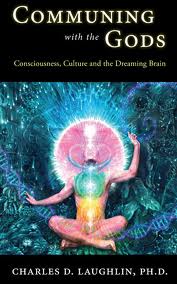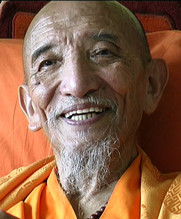 Whenever I have had a spare moment for the past three months, I’ve been sneaking peaks at Charles Laughlin’s new book Communing with the gods: Consciousness, culture and the dreaming brain. It’s a tome, over 500 pages long, and because of its girth I have approached the volume each time with some hesitancy… and a little fear. But each time I’ve dived in, I’ve come away with big ideas, and also some unusual clarity.
Whenever I have had a spare moment for the past three months, I’ve been sneaking peaks at Charles Laughlin’s new book Communing with the gods: Consciousness, culture and the dreaming brain. It’s a tome, over 500 pages long, and because of its girth I have approached the volume each time with some hesitancy… and a little fear. But each time I’ve dived in, I’ve come away with big ideas, and also some unusual clarity.
This book is may be heavy, but it’s really approachable for an academic text.
That’s an accomplishment for a book that essentially takes on the weighty task of summing up the topic of dreams in cross-culture perspective, including the evolutionary impact of the dreaming mind on our species, history, religion and art. Laughlin does this remarkably well, and he tells some great personal stories along the way.
There’s really only a few people in the world who have the personal experience and the scholarly prowess to single-handedly write an anthropology of dreams. In fact, no one has attempted this feat in a generation or longer.
Personal and Academic

Laughlin, a professor emeritus at Carleton University in Ottawa, Canada, has decades of fieldwork experience with dreaming cultures, including locales such as Nepal and Uganda, and, on his home continent, he is an expert in Navajo shamanism.
His interest in dreaming grew over the years as he also worked intensely with several dream yoga systems, including Tibetan Buddhism under the direction of Chogye Trichen Rinpoche. So for Laughlin, dreaming is no academic matter, but a personal avenue for growth and exploration into the deep structures of the mind.
This personal perspective is woven into all chapters of Communing with the Gods (published by Daily Grail Press), and it serves to bring the intense ideas and sophisticated discussions back to earth. This method of storytelling is not only fascinating, but it actually exposes one of the book’s core concepts: that dreaming is an experience of the conscious mind, first, and a cultural construct second.
[pullquote]Dreaming is an experience of the conscious mind[/pullquote]
To say it another way, dreaming is living. And when we discuss our dreams, it’s critical to give this primary respect to our gritty, personal, embodied moments of life that happen to take place in the dreaming state of consciousness.
From this grounded approach, Laughlin gives a history of dreams in anthropology, and then spends the bulk of the book reviewing the current anthropological theories of dreams as they intersect with actual dreamers in actual cultures.
Integrating the science of dreaming
As many have noted before, there is no current “big theory” in the anthropology of dreaming; researchers tend to follow their own interests and illuminate only part of the mystery and the promise of dreaming. Laughlin’s wide knowledge base really comes in handy at this junction, as he is able to respect many lines of inquiry into dreaming, without prizing one over another.
[pullquote]There is no current “big theory” in the anthropology of dreaming[/pullquote]
In this way, the overarching psychological truths of Carl Jung are on par with the very personal work with lucid dreamer George Gillespie, and the neurological work of sleep scientists is contextualized with the findings of ethnographers.
This alone is very helpful… but Laughlin goes further, as he presents this information in a way that builds his central argument, which is the presentation of his own theory of dreaming, which he calls the neuroanthropological theory of dreaming.
The Neuroanthropological theory of Dreaming
Laughlin trained as a neuroscientist, and then became an adept ethnographer. These two strands of knowledge combine with his embodied experience to form his theory of how dreaming is processed in the brain and how the experience of dreaming is applied across cultures.

In Laughlin’s view, and I wholeheartedly agree, no theory of dreaming that doesn’t include the mechanisms of the brain AND the evolution of the human animal AND the weird and wonderful application of dreaming as a social medium AND the full spectrum of self-awareness in dreams can be complete.
His approach is pragmatic, and draws heavily from evolutionary biology. Avoiding the morass of defining consciousness as a linguistic construct, Laughlin still points out that dream sharing is as much a result of language as it is the ability to remember our interior experiences in the first place (thank you higher brain). They probably came together, reinforcing the value of the dreaming mind due to its apparent knack for predicting the future, problem-solving, and exposing social tensions.
This biological grounding is why people have similar dreams throughout history and across cultures too. Laughlin says,
Visits with deceased ancestors, flying and OBEs, mandala-like geometric forms, shape-shifting beings, journeys to spiritual places, violent struggles, snakes and other totemic animals, witches, ghosts, spirits that cause and heal sickness, encounters with teachers or gurus, anima and animus figures, marriage, death, and so forth inhabit the dreaming of peoples all over the planet. Yet in every case, the motif will tend to be colored by cultural conditioning. Who is marrying whom…the place to which one is flying…what nastiness the witch is bent on doing… all these things vary depending upon the conditioning and information available in the culture.” (p. 461).
The development of lucid dreaming
This should come with no surprise if you read my blog regularly, but what I love about Laughlin’s book is his inclusion of the full spectrum of dreaming, including the relatively rare ability to lucid dream, or dream with self-awareness.
[pullquote]’Normal’ dreaming we Westerners take for granted is actually quite primitive compared to lucid dreaming.[/pullquote]
He really puts it perspective: some cultures invest in the ability to lucid dream, and some don’t. Those that do have a system of beliefs that allows them to train their minds to think clearly and with intentionality in the dreamspace. The mind training is about learning rituals that involve the prefrontal cortex (PFC) in dreams.
In those that don’t (such as most of Western culture), dreams tend to be viewed as random, meaningless events that happen to us.
Laughlin takes our culture to task here: “In a sense, the ‘normal’ dreaming we Westerners take for granted is actually quite primitive compared to lucid dreaming. I mean this literally—dreaming bereft of PFC mediation is a kind of throwback to the dreaming of hominins prior to the evolution of language.” (p. 461).
The application of lucid dreaming across cultures, of course, is largely shamanistic. Dream shaman are those who can direct their awareness in the dream state, fly to destinations to retrieve information, direct healing as well as sorcery, and transform the dreambody into animal and plant forms.
That doesn’t mean every lucid dreamer is a shaman, of course, a point I’ve made before.
But this historic and cross-cultural lens reveals that lucid dreamers are often swimming in shamanic waters without a clue of the power of the dreaming mind.
In conclusion
Communing with the gods is pretty dense, so it’s probably not the most appropriate text for dream beginners or those unfamiliar with some academic language. But if you are interested in the anthropology of dreaming, this belongs on your book shelf. Laughlin has done a great service to the field of dream studies. In my mind, it’s an instant classic, the distillation of decades of careful scholarship and intensely personal experiences.
Sounds awesome.
Hope I can get it on Kindle.
I think it’s paperback only right now Morgan.
Sounds like such a fascinating book that I ordered it from Amazon, and just received my order. Hope it is good!